on Fair Isle
sheep graze
treeless grassy slopes
bound by lichened stony walls
aging fences
rocky cliffs
and the sea.

With similar latitudes, it is hard for me to imagine Cordova treeless, or to even attempt to visualize Cordova's rock and mossy wild forests smoothed and tamed by the presence of sheep and strings of stone walls. Interestingly enough, there does happen to be one sheep in Cordova, whose breed just happens to be Shetland, brought here from inland Alaska. His name is Shaun, but he is solitary and no rolling hills for him. As I walk alongside the trailing lichen encrusted stone walls, I wonder, did Fair Isle ever have trees, or was it always this way with its bare windswept dramatic hillsides. The interplay of man's intervention with geography and biology is that which determines past, present, and future. Despite the lack of trees, and markings of many years of civilization on the island, Fair Isle still retains a sense of wildness about it.
I have always liked lichens. Perhaps, also from my Colorado mountain climbing days. As I walked past row after row of these lichen covered rocks, I looked closely, searching to find any recognizable forms, but I am not enough of a lichenologist to know exactly what I was seeing, other than just liking what I saw. I wondered to myself who had stacked all these stones, and how much lichen dyeing had occurred on the island over the years. My head was full of unanswered questions.
I followed the lane beside the rock walls to the cottage of knitting designer Mati Ventrillon, who was expecting me, as Tommy had given her a call and let her know I might be stopping by. I briefly met in her home business studio, and felt an instant liking to her and only wish we had been able to spend more time together, but grateful for the moments and dialogue in the time we shared.
A more recent resident on the island, Mati and I also discussed this concept of tradition, which had been an underlying theme since I had arrived on the island. I shared with her my ideas on the Cordova Gansey Project and she explained to me the project she was working on. In some ways, it shared some similarities, as she was attempting to bring new life to the Fair Isle garments, hoping to create something new out of an old tradition. I was feeling on the verge of bringing the fisherman gansey tradition a new life and home in Alaska. Not that ganseys aren't being knit, or being designed currently with new adaptations, but the fishermen in our area have not as a group worn hand knit wool sweaters like those fishermen of the past. I wondered if it would work, or if it was ok to borrow these cultural traditions for our own fleet of fisherfolk.
I asked her how she felt about tradition and that tug of war between honoring the old and introducing the new and where the two intertwine. In response, here is the quote she shared with me.

From her perspective, tradition is not static or stagnant. It is as alive as the knitters that take knitting on new ventures. In conjunction with my conversations with Kathy, my time with Mati helped me make that final leap in forming the foundation for my ideas concerning the gansey project and another Fiber and Friends that would center around the fisherfolk and their knitting traditions that we would take hold of.
For me, as I think of it, the goal is not to lose or dishonor the past. Time marches on, people move and migrate, and cultures, ideas, designs and practices merge and meld. For these places like Shetland and Fair Isle, I found a legitimate concern that culture and traditions, especially in regard to textiles, not be lost or forgotten, and even with some, manipulated. Hopefully, there is a remnant that continues to honor the past and perpetuate the honored traditions alongside those who may want to take those traditions and allow them to manifest into something new. I have seen this said as "not only preservation but perpetuation", for in bringing new life to old patterns, alongside the old, there can be rebirth and continued industry and an assurance that the craft is kept alive. It is a challenge to balance the two sometimes, but they can be compatible and work together, like a treaty of mutual respect between the past and the present. But credit should be given where credit is due and the patterns and creations of the island of Fair Isle need to be remembered and referenced accordingly, and those who have worked and strived to preserve them need to be acknowledged and supported.
Mati's pieces are creative and unique, and I was inspired by her work. She was still in the setting up stages while I was there, and I was pleased to see recently on her Facebook page photos of her current makings. If you have a moment this youtube video gives you a less than two minute peek at what she is up to.
I appreciated this short, yet meaningful visit with Mati, and then wandered "home" in the near dark, After dinner, and an insisted upon mandatory glass of fine scotch whiskey (not my usual, but all part of the experience) and deliciously wonderful citrus sponge cake, we were off to the birder's meeting of the week.
Just as Cordova and the Copper River Delta attracts both birds and birders due to its geography and location, Fair Isle is known as a birding destination, so much so they even have a birders lodge, observatory, and evening programs. I brought my knitting and knit away as the speaker shared bird news, then called out a long list of birds, as birders acknowleged their sightings. For the night, my treasure was found in the lodge's adjoining gift shop, where I was able to purchase a couple of authentic hats, machine knit on the island by Elizabeth Riddiford, one a genuine fisherman's kep in traditional colors. I still didn't know very much about what was what, but I knew I liked them and the kep reminded me of all those I had seen in the museum. After I returned home and was able to read more and fill in more of the blanks, I was glad for what I had purchased at the birder's building, as I came to a more full understanding of the roll the fisherman's kep had in the development of the concept of "Fair Isle" as a distinct pattern form.

Though some things are logical, sometimes it takes time for me to connect the dots, but then the obvious seems obvious. Recently I was reading about how there used to be even more birds on the island, before the herring went away. The birds followed the herring just like the fishermen. When the fish were gone, the fishermen were gone, and the birds as well, and the general population of the island declined as well. Maybe I wouldn't know the difference with my limited knowledge or familiarity, but an Islander would know, just like we know in Cordova when the fishing runs are weak or strong, and are sensitive to fluctuations and effect on the entire community.
I am still trying to understand what happened and how the progression of efficiency moved faster than the understanding of the damages done. When you look at the history of the island of Fair Isle, it speaks of fishing having been an important industry for many many years. When you are in a fishing family and you are visiting a place that once was a fishing place and now isn't, you wonder, could this happen to your own region as well. It might not be for the same reasons, as our area is carefully regulated, but you never know the other factors that might come in to play.
In the meantime, I will knit for the present fishermen in my family in the active and sustainable fishery that presently exists, being attentive and responsible for those things we do have control over. I think also I now feel grateful to be in this time and place where wild salmon runs still provide a healthy and viable source of food, income, and lifestyle for our coastal community.
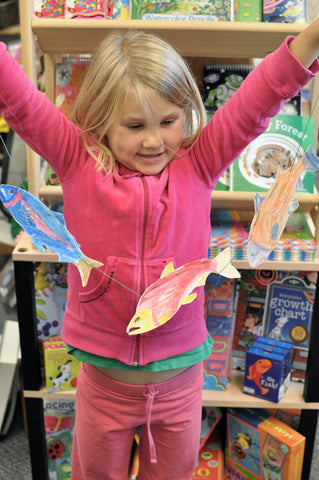
So much learned, so much to think about, so much more to learn. I had a treasure in my pocket from this journey around the planet. These traditions I had witnessed, including Fair Isle’s rich fishing and knitting history, as well as what was transforming from them in color and pattern would follow me home and onward to new ground.
Like a dream these days had been. It is all that I have shared and so much more. My welcome had now become a farewell, and such a welcome it had been that I could not contain the smiles within me.
And what a sweet and friendly face as part of the flight crew, to send me on my way, it was Mati.
.
Fare thee well Fair Isle..
Eventually, in England, after finishing up a wood engraving workshop at West Dean College, I had a day to visit a living history park of historic houses that had been saved and brought to the property, many of which had been in near ruin before their rescue. On display, there was these beautiful hand painted panels that had been uncovered behind various wall "makeovers" of a house that was to be demolished, now under glass for all to see and appreciate.
As I went to take a photo of the wall of illuminated design, I saw my reflection in the protective glass and I thought of the past and present merging in that moment, and via the photograph, the two becoming one, my image being cast into a new and unique creation where my presence was as integral as the original works of someone's hand.
Perhaps this is akin to what becomes of the designs and inspirations from the past that each of us connect ourselves to and with through our knitting. We create something new and fresh with a part of us in it, and thus become an integral part of the melding of past and present. For me this has to do with that fishing and knitting connection that has drawn me in and revealed itself to me along the way, bit by bit. I just cannot escape or get away from it. Though not always searching for it, it somehow finds me, and so, at least for now, I have given way to it.
Down River...Chapter 9
Credits: Sheep and Auld Haa Guest House etching by Tommy's father, Roger Hyndman. For more info on his solar printing techiniques: http://www.solarprintmaking.com/about-the-artist/

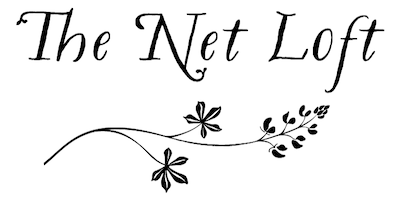






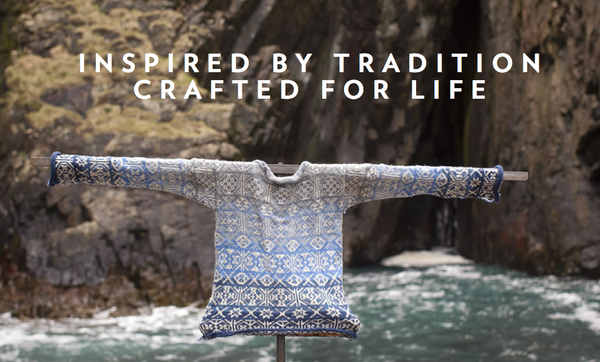


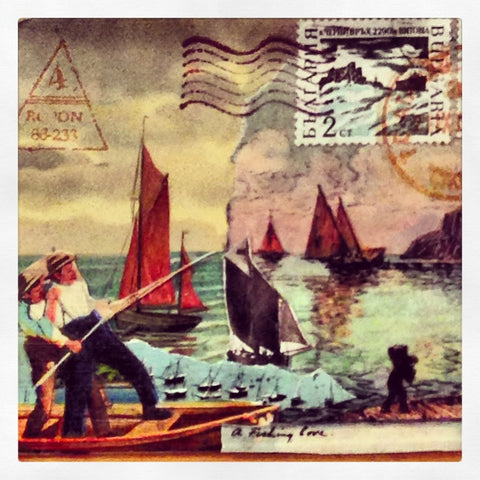





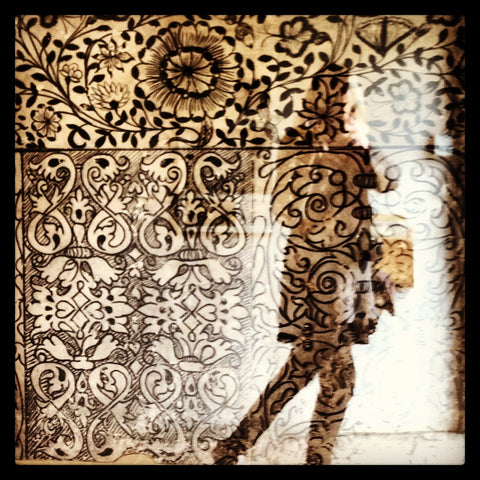
3 comments
I love what you do and how you share your life adventure! You are one of the best things that ever happened to Cordova. Every time I see THE GANSEY PROJECT or read about it, I am filled with inspiration and appreciation for what the human hands and mind can do.
Such a beautiful story and a wonderful way to look at tradition. Your story brings my far off attraction to both Alaska and the island of Fair Isle back to the forefront once again. I love the designs and rich traditions ~ with no real reason as to why. Perhaps that 100+ year old flax wheel in the living room and the vibes it sends off … Thank you! And I can’t wait to read more :-)
Wonderful story of discovery & adventure! Such a pleasure to have had you at the Auld Haa Guesthouse. Cheers Tommy